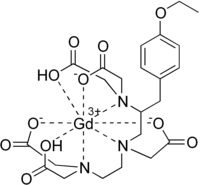
Photo from wikipedia
Objectives: To explore the potential of radiomics on gadoxetate disodium-enhanced MRI for predicting hepatocellular carcinoma (HCC) response after transarterial embolization (TAE). Methods: This retrospective study included cirrhotic patients treated with… Click to show full abstract
Objectives: To explore the potential of radiomics on gadoxetate disodium-enhanced MRI for predicting hepatocellular carcinoma (HCC) response after transarterial embolization (TAE). Methods: This retrospective study included cirrhotic patients treated with TAE for unifocal HCC naïve to treatments. Each patient underwent gadoxetate disodium-enhanced MRI. Radiomics analysis was performed by segmenting the lesions on portal venous (PVP), 3-min transitional, and 20-min hepatobiliary (HBP) phases. Clinical data, laboratory variables, and qualitative features based on LI-RADSv2018 were assessed. Reference standard was based on mRECIST response criteria. Two different radiomics models were constructed, a statistical model based on logistic regression with elastic net penalty (model 1) and a computational model based on a hybrid descriptive-inferential feature extraction method (model 2). Areas under the ROC curves (AUC) were calculated. Results: The final population included 51 patients with HCC (median size 20 mm). Complete and objective responses were obtained in 14 (27.4%) and 29 (56.9%) patients, respectively. Model 1 showed the highest performance on PVP for predicting objective response with an AUC of 0.733, sensitivity of 100%, and specificity of 40.0% in the test set. Model 2 demonstrated similar performances on PVP and HBP for predicting objective response, with an AUC of 0.791, sensitivity of 71.3%, specificity of 61.7% on PVP, and AUC of 0.790, sensitivity of 58.8%, and specificity of 90.1% on HBP. Conclusions: Radiomics models based on gadoxetate disodium-enhanced MRI can achieve good performance for predicting response of HCCs treated with TAE.
Journal Title: Diagnostics
Year Published: 2022
Link to full text (if available)
Share on Social Media: Sign Up to like & get
recommendations!